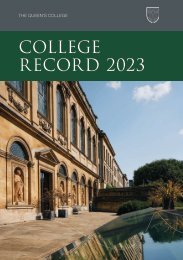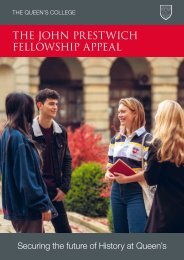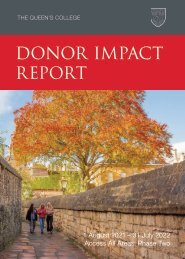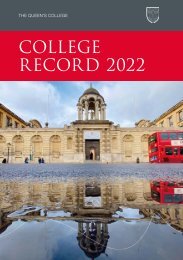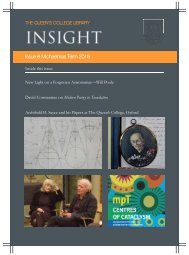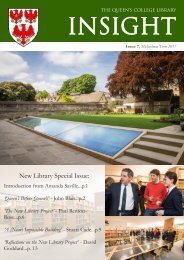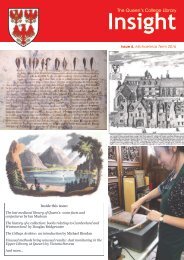Eagle Eye Magazine Issue 1 2023
Take a dive into the research and work that's going on at The Queen's College and beyond its walls within the community of Old Members. In issue one, we celebrate Shakespeare's First Folio, ask our history Fellows what makes them passionate about their subject, explore the new accessible Porters' Lodge, ask a current student about how to engage positively with climate issues, and much more.
Take a dive into the research and work that's going on at The Queen's College and beyond its walls within the community of Old Members. In issue one, we celebrate Shakespeare's First Folio, ask our history Fellows what makes them passionate about their subject, explore the new accessible Porters' Lodge, ask a current student about how to engage positively with climate issues, and much more.
Create successful ePaper yourself
Turn your PDF publications into a flip-book with our unique Google optimized e-Paper software.
the climate crisis, the biodiversity crisis, sewage in rivers, etc.<br />
Yet misunderstandings persist and disinformation is rife. We<br />
therefore desperately need scientists to better explain their science<br />
in a language that engages people. I also think that knowing more<br />
about biology can really enrich your everyday experience. I always<br />
see something interesting every time I leave the house!<br />
You’re leading a long-term study into the value of the<br />
Ridgeway National Trail for conserving the biodiversity<br />
associated with chalk grassland. Can you explain what<br />
biodiversity means and why it’s so crucial?<br />
Biodiversity is an overused word, but it’s just a shorthand for all<br />
biological variation. Most people probably think only of species<br />
diversity, but there’s important genetic variation within species<br />
that needs to be preserved. For example, the red kite wasn’t<br />
extinct in the UK, but the tiny remnant population in Wales was<br />
incapable of spreading further. Once new birds were brought from<br />
a large Swedish population, the population boomed, and it’s now<br />
common to see them over the College. I don’t know for certain,<br />
but I suspect that the new birds are in much better genetic health,<br />
and that’s the main reason for their success.<br />
What will be the focus of your work on this project over the<br />
summer vacation?<br />
On The Ridgeway we are trying to restore degraded chalk<br />
grassland on the verges of the National Trail. When properly<br />
managed, chalk grassland is one of the most species-rich habitats<br />
on the planet. But if you don’t manage it properly, you lose all the<br />
wildflowers and grass takes over. Grazing animals used to manage<br />
it naturally but keeping animals on the trail isn’t compatible with<br />
public access, as so many people have dogs. We have trialled a<br />
mowing regime that takes place in late August, once plants have<br />
set seed, and it’s been very successful. We are also sowing back<br />
the species that have been lost. Now we want to scale up from<br />
our small experiment and engage the farmers in the management<br />
regime. In fact, we’ve already started doing this, so I hope that<br />
in a few years, you will be able to see an incredible variety of<br />
wildflowers along The Ridgeway, instead of a monoculture<br />
of grass.<br />
When you’re not teaching or doing research, you are also the<br />
Garden Fellow at Queen’s. What has been your vision for the<br />
College gardens?<br />
A good garden is one with a particular atmosphere and at Queen’s<br />
I think Andrew Timms (the current Bursar) sums it up when he<br />
says we’ve gone for cottage garden on steroids! We’ve done a lot in<br />
the past eight years. My first action was to plant the cherry trees<br />
in Front Quad, which was quite contentious at the time, but I love<br />
the way they change with the seasons. The area under the holm<br />
oak has also been transformed and is now planted with shadeloving<br />
shrubs (thanks to a comment from an Old Member!).<br />
We’ve also thinned the canopy of the oak to reduce the shade it<br />
casts, and to stop it encroaching on the buildings.<br />
Restoring the Provost’s Garden following the New Library project<br />
was probably the biggest challenge, but I’m very happy with the<br />
outcome. The overall vision for the garden is to support biological<br />
diversity, and therefore the local wildlife, but also to have a garden<br />
that looks good all year round. On the wildlife front, we have<br />
nesting blue tits, wrens, blackbirds, doves, and even ducks. We<br />
also have solitary bees nesting in the bee boxes. An inter-collegiate<br />
study found that we actually have the highest diversity of bees<br />
across all colleges, perhaps because we don’t use any chemicals in<br />
the borders and have such a high diversity of plants.<br />
It’s also important that people can enjoy the gardens, so we<br />
ordered more garden furniture, which is now used for picnics,<br />
studying, teaching and some meetings (like this interview!).<br />
What’s the best thing people can do in their own gardens to<br />
support biodiversity?<br />
One crucial way that gardeners can help is to support insects,<br />
which have declined terribly and are essential food for other<br />
animals, like birds. Insects are best supported by native perennial<br />
plants – if you’ve got space for a small area of meadow – that’s<br />
really the best. I’ve been amazed how many insects I get in my<br />
own ‘meadow’, but it does look a bit untidy, so it’s not everyone’s<br />
cup of tea. Otherwise, try to plant perennials, rather than bedding<br />
plants, which normally produce little or no pollen. My top tip for<br />
acquiring new plants for your garden: ask your neighbours to split<br />
plants and share cuttings. Chances are, if it flourishes in their<br />
gardens, it will in yours too.<br />
Tell us what makes your favourite animal, the sea hare, special?<br />
It’s hard to pick a favourite, but I chose the sea hare because,<br />
although they can be found in the UK, they’re really quite exotic<br />
and fundamentally strange. I’ve spent years hunting for them<br />
in rock pools and it brings me a lot of joy to wonder at their<br />
weirdness.<br />
Greater Yellow-rattle<br />
Photo: iStock.com/Toro Attila<br />
And, since your full title is Fellow in Plant Sciences, do you<br />
have a favourite plant as well?<br />
I don’t really have a favourite, but I marvel at the yellow-rattle.<br />
It’s hemi-parasitic and lives in UK grasslands, parasitising the<br />
grasses but not the wildflowers. For this reason, it’s also known<br />
as the meadow-maker, as it helps wildflowers to thrive among the<br />
dominant grasses.<br />
17






